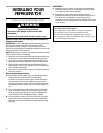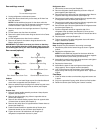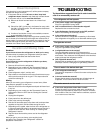
13
■ Has a large amount of food just been added to the
refrigerator?
Adding a large amount of food warms the refrigerator. It is
normal for the motor to run longer in order to cool the
refrigerator back down. See the “Refrigerator Features”
section.
■ Are the doors opened often?
Expect the motor to run longer when this occurs. In order to
conserve energy, try to get everything you need out of the
refrigerator at once, keep food organized so it is easy to find,
and close the door as soon as the food is removed.
■ Is the control set correctly for the surrounding
conditions?
Refer to the “Setting the Control(s)” section.
■ Are the doors closed completely?
Push the doors firmly shut. If they will not shut all the way, see
“The doors will not close completely” later in this section.
■ Are the condenser coils dirty?
This prevents air transfer and makes the motor work harder.
Clean the condenser coils. Refer to the “Cleaning Your
Refrigerator” section.
NOTE: Your new refrigerator will run longer than your old one due
to its high efficiency motor.
The refrigerator seems to make too much noise
■ The sounds may be normal for your refrigerators.
Refer to the “Understanding Sounds You May Hear” section.
The divider between the two compartments is warm
The warmth is probably due to normal operation of the automatic
exterior moisture control.
Temperature is too warm
■ Are the air vents blocked in either compartment? This
prevents the movement of cold air from the freezer to the
refrigerator.
Remove any objects from in front of the air vents. Refer to
“Ensuring Proper Air Circulation” for the location of air vents.
■ Are the door(s) opened often?
Be aware that the refrigerator will warm when this occurs. In
order to keep the refrigerator cool, try to get everything you
need out of the refrigerator at once, keep food organized so it
is easy to find, and close the door as soon as the food is
removed.
■ Has a large amount of food just been added to the
refrigerator or freezer?
Adding a large amount of food warms the refrigerator. It can
take several hours for the refrigerator to return to the normal
temperature.
■ Is the control set correctly for the surrounding
conditions?
Refer to the “Setting the Control(s)” section.
There is interior moisture build-up
■ Are the air vents blocked in the refrigerator?
Remove any objects from in front of the air vents. Refer to
“Ensuring Proper Air Circulation” for the location of air vents.
■ Is the door opened often?
To avoid humidity build-up, try to get everything you need out
of the refrigerator at once, keep food organized so it is easy
to find, and close the door as soon as the food is removed.
(When the door is opened, humidity from the room air enters
the refrigerator. The more often the door is opened, the faster
humidity builds up, especially when the room itself is very
humid.)
■ Is the room humid?
It is normal for moisture to build up inside the refrigerator
when the room air is humid.
■ Is the food packaged correctly?
Check that all food is securely wrapped. If necessary,
repackage food according to the guidelines in the
“Refrigerator Features” section. Wipe off damp food
containers before placing in the refrigerator.
■ Is the control set correctly for the surrounding
conditions?
Refer to the “Setting the Control(s)” section.
■ Was a self-defrost cycle completed?
It is normal for droplets to form on the back wall after the
refrigerator self-defrosts.
The doors are difficult to open
■ Are the gaskets dirty or sticky?
Clean gaskets and the surface that they touch. Rub a thin
coat of paraffin wax on the gaskets following cleaning.


















